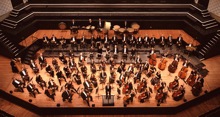Symphony
Eymology
OF. simphonie (from 12th c.), mod.F. symphonie = It., Sp. sinfonia, Pg. senfoni, ad. L. symphnia sound of instruments, instrumental harmony, voices in concert, musical instrument (Dan. iii. 5, Luke xv. 25), a. Gr. agreement or concord of sound, concert of vocal or instrumental music, ?musical instrument, f. harmonious, f. SYM- + sound.
Definition
- 1. Used vaguely, after late L. symphnia, as a name for different musical instruments. (See also SYMPHAN.) Obs.
- 2. Harmony of sound, esp. of musical sounds; concord, consonance. Also occas. of speech-sounds, as in verse. Now rare or Obs.
- 3. Harmony (in general), agreement, accord, concord, congruity. Now rare or Obs.
- 4. a. (transf. from 2.) Music in parts, sung or played by a number of performers with pleasing effect; concerted or harmonious music; a performance or strain of such music. Chiefly poet. or rhet.
- b. fig. A collection of utterances, or sounds of any kind, likened to concerted music; a ‘chorus’ (of praise, etc.).
- c. Applied to a collection or composition of various colours which harmonize, with pleasing or brilliant effect.
- 5. Mus. a. A passage for instruments alone (or, by extension, for a single instrument) occurring in a vocal composition as an introduction, interlude, or close to an accompaniment (partly = RITORNELLO); also, a short instrumental movement occurring between vocal movements, as the ‘Pastoral Symphony’ in Handel's ‘Messiah’; also formerly applied to a more extended instrumental piece, often in several movements, forming the overture to an opera or other vocal work of large dimensions (cf. next sense).
- b. An elaborate orchestral composition in three or more movements, originally developed from the operative overture (see prec. sense), similar in form to a sonata, but usually of grander dimensions and broader style.
- c. Singing by the whole of a choir or congregation together. Obs.
- d. ellipt. for ‘symphony orchestra’.
- 6. attrib. and Comb., as (sense 5b) symphony concert, form, orchestra.
Description
A term now normally taken to signify an extended work for orchestra. The symphony became the chief vehicle of orchestral music in the late 18th century, and from the time of Beethoven came to be regarded as its highest and most exalted form. The adjective ‘symphonic’ applied to a work implies that it is extended and thoroughly developed.
The word ‘symphony’ derives from the Greek syn (‘together’) and phÅnÄ“ (‘sounding’), through the Latin SYMPHONIA, a term used during the Middle Ages and the Renaissance. It is essentially in this derivation that the term was used by Giovanni Gabrieli (Sacrae symphoniae, 1597), Heinrich Schütz (Symphoniae sacrae, 1629) and others for concerted motets, usually for voices and instruments. In the 17th century the term ‘symphony’ or (more commonly) ‘sinfonia’ was applied to introductory movements to operas, oratorios and cantatas (see OVERTURE, §2–3), to the instrumental introductions and ritornellos of arias and ensembles (see RITORNELLO), and to ensemble works that could be classified as sonatas or concertos. The common factor in this variety of usage was that sinfonias or symphonies were usually part of a larger framework, such as another composition, an ‘academy’ or a ‘church service.
The immediate antecedent of the modern symphony is commonly considered to be the opera sinfonia, which by the early 18th century had a standard structure of three sections or movements: fast, slow, and fast dance-like movement. That form was extensively used by Alessandro Scarlatti and his contemporaries and was widely adopted outside Italy, particularly in Germany and England (less in France, where the FRENCH OVERTURE held sway). The terms ‘overture’ and ‘symphony or ‘sinfonia’ were widely regarded as interchangeable for much of the 18th century.
